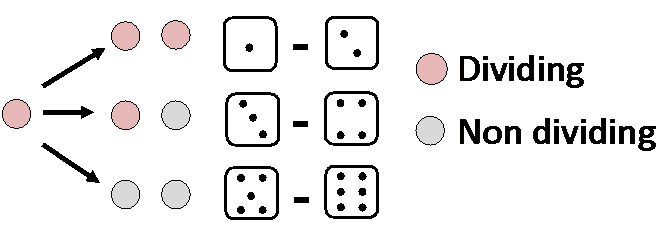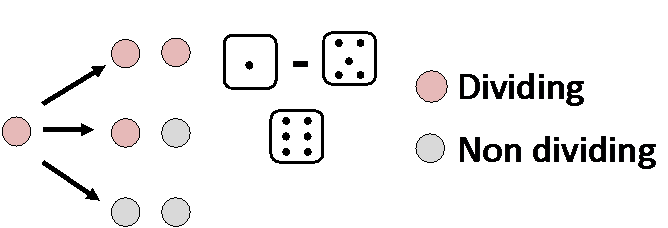Skin cells play ‘dice games’

Rules of the ‘Maintenance Game’ in skin cell division:
In this game, a dice roll of 1 or 2 would give two dividing daughter cells, 3 or 4 results in one dividing and one not and 5 or 6 gives two non-dividing cells, leading to an evolutionary dead-end for that cell. With thousands of players, a 50:50 balance of dividing and non-dividing cells results.
How to maintain healthy skin and heal wounds is an intricate problem. Maintaining the skin requires exactly the right number of cells to divide to replace those shed from the skin surface. Too many cell divisions can lead to cancer, whereas too few will result in ulcers. Wound healing needs a short burst of cell production to fill the gap in the skin. Latest research shows that all dividing skin cells can flip between two probability game modes and so have the potential to both maintain and heal skin, challenging the view that only rare stem cells matter.

Rules of the ‘Wound-healing Game’ in skin cell division:
The odds of producing dividing cells are much higher than for non-dividing cells, ensuring excess dividing cells are produced to heal a wound.
Understanding the rules of the games not only explains how skin maintains itself and heals wounds, but also shows how skin grafts work and suggests how changes to the rules could lead to cancer.
Watching high definition movies of human skin cells dividing in real time showed they play two types of dice game, for maintenance or wound repair. In the maintenance game, the odds are balanced between production and shedding, with a 50:50 chance of a daughter cell going on to divide or stopping division and migrating to the skin surface. These probabilities keep the skin in balance. However, cells next to a wound temporarily switch to the repair game, in which the odds of producing dividing cells are nine times higher, ensuring rapid healing.
“This research demonstrates that dividing human skin cells can switch their behaviour between these two modes of maintenance or repair, challenging the longstanding view that skin renewal and healing relies on a special population of stem cells.”
Dr Phil Jones Senior group leader at the Wellcome Trust Sanger Institute and MRC Cancer Unit, University of Cambridge
To carry out the investigation of skin turnover, researchers took live imaging movies of more than 3,000 human skin cells dividing in culture. The images showed that single cells expanded exponentially in repair mode until they had produced multi-layered sheets of cells, after which the behaviour switched to maintenance mode. However, this is only half the story.
“By scratching sheets of cells in the balanced mode and observing cells next to the scrape, we saw that they changed into wound healing mode until the scratch was closed again. The cells could switch backwards and forwards between the two states as required, proving that the behaviours were reversible.”
Dr Joanna Fowler An author of the paper from the Sanger Institute
Skin loss due to burns or ulcers that won’t heal can be fatal and skin graft surgery is used to replace burnt or damaged skin. Sheets of skin can be grown from very small skin patches in the laboratory, and this can save the lives of patients with serious burns.
“As plastic surgeons, we have been growing sheets of skin from burns patients to save lives for decades. A single skin cell can create a patch of one centimetre diameter or more, and many of these together can make a whole sheet. However until now we couldn’t explain how this worked. This research explains how skin cell cultures expand, and could lead to further improvements in wound healing in the clinic.”
Dr Amit Roshan First author and Cambridge Cancer Centre Clinical Research Fellow at MRC Cancer Unit, Cambridge
The cells appeared to sense when their neighbours were missing, flipping from maintenance to wound healing behaviour: once they were surrounded by cells again, they flipped back. Inhibiting a cell signalling protein ROCK2 kinase prevented cells in expanding mode flipping back into balanced mode, indicating that cell signalling was required to make the switch. In further corroboration of the two mode games, the investigators found differences in gene expression between wound healing and balanced populations of cells.
“These findings have great implications for understanding cancer, where cells have too many dividing daughters. Mutations could change the rules of the game and load the dice in favour of dividing cells, leading to cancer. The knowledge that all dividing skin cells are the same but can switch their behaviour will help us understand how DNA changes associated with cancer alter cell behaviour.”
Dr Phil Jones
More information
Publication:
Amit Roshan et al., 2015. Human Keratinocytes have two interconvertible modes of Proliferation. Nature Cell Biology DOI: 10.1038/ncb3282
Funding
This work was supported by the Wellcome Trust, Cambridge Cancer Centre, Medical Research Council, the NC3Rs (National Centre for the Replacement, Refinement and Reduction of Animals in Research) and Cancer Research UK (Programme grant C609/A17257)
Participating Centres
- MRC Cancer Unit, University of Cambridge, Hutchison/MRC Research Centre, Box 197, Cambridge Biomedical Campus, Cambridge, United Kingdom CB2 0XZ
- Cambridge University Hospitals NHS Foundation Trust, Hills Road, Cambridge CB2 0QQ
- Wellcome Trust Sanger Institute, Hinxton, Cambridge, United Kingdom CB10 1SA
- Cavendish Laboratory, TCM, University of Cambridge, JJ Thomson Avenue, Cambridge, United Kingdom CB3 0HE
- Wellcome Trust/Cancer Research UK Gurdon Institute, The Henry Wellcome Building of Cancer and Developmental Biology, University of Cambridge, Tennis Court Road, Cambridge, United Kingdom CB2 1QN
Selected websites
The MRC Cancer Unit
The MRC Cancer Unit is both a core-funded Unit of the UK Medical Research Council, as well as an academic department of the School of Clinical Medicine at the University of Cambridge. Its mission is to study the earliest steps in the development of cancer, and translate this knowledge to clinical application for the benefit of patients. The Unit aims to improve the early detection of cancer, to help identify individuals who are most at risk of developing cancer, and to create more effective treatments for cancer, through the invention of innovative technologies. Early intervention in cancer through improvements in prevention, detection and treatment offers tremendous promise in combating the disease. Our Unit is one of only a few centres worldwide whose mission is to address this priority.
The Wellcome Trust Sanger Institute
The Wellcome Trust Sanger Institute is one of the world’s leading genome centres. Through its ability to conduct research at scale, it is able to engage in bold and long-term exploratory projects that are designed to influence and empower medical science globally. Institute research findings, generated through its own research programmes and through its leading role in international consortia, are being used to develop new diagnostics and treatments for human disease.
The Wellcome Trust
The Wellcome Trust is a global charitable foundation dedicated to achieving extraordinary improvements in human and animal health. We support the brightest minds in biomedical research and the medical humanities. Our breadth of support includes public engagement, education and the application of research to improve health. We are independent of both political and commercial interests.


